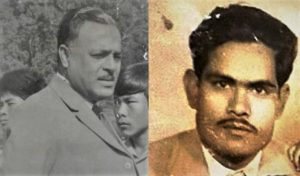A little known chapter of the 1971 War of Liberation in Bangladesh was the role of some officers from the northeastern Indian state of Assam, which borders Bangladesh (East Pakistan until 1971). These officers trained and equipped thousands of freedom fighters of the Mukti Bahini to take on the Pakistani army.
Two officers, Jnanananda Sarma Pathak and Biraja Nanda Choudhury, who belonged to the Special Security Bureau (SSB), considered the “guerrilla wing” of India’s external intelligence agency, the Research & Analysis Wing (RAW), played an exemplary role in the Liberation War.
Pathak was a deputy inspector general from the Assam cadre of the Indian Police Service and was deputed to the SSB two years before the Liberation War to manage the SSB’s operations in the border regions of India’s northeast. The SSB’s primary role was to train the local populace living along the India-China border in subversive activities to prevent China’s People’s Liberation Army from making incursions into India.
Choudhury was a political officer in the border state of Arunachal Pradesh from where he was deputed to serve in the SSB as a senior instructor. He had undergone extensive training on demolition tactics at Mahabaleswar in Maharashtra.
Pathak and Choudhury were commissioned when RAW decided to step in to train Mukti Bahini functionaries, which was mostly undertaken by the Indian army in an exercise codenamed Operation Jackpot.
“The module was fine-tuned at the Salonibari establishment of the 27SSB Battalion near Tezpur in Assam following a series of discussions among senior officers of the organization. They decided to begin the training of the Mukti Bahini functionaries in Lower Haflong without delay,” recalled Vijayanta, the son of Pathak, who is currently the chief sub-editor of The Assam Tribune. Lower Haflong is a stretch of hilly terrain in Assam’s Dima Hasao district. It is located around 150 kilometers from the India-Bangladesh border and was considered an ideal location for training the Mukti Bahini.
According to Vijayanta, “Close to 10,000 functionaries underwent training at the center in several batches. The course was brief and lasted for around two months after which they were infiltrated into East Pakistan. “On some occasions, personnel from the SSB crossed the border into Bangladesh with the trained fighters,” Vijayanta said. “Many of them never returned home.”
On March 25, 1971, the Pakistan Army launched a brutal crackdown in East Pakistan. The Mukti Bahini emerged soon after. Within a couple of months, it had evolved into a huge organization of armed and trained men owing allegiance to the provisional government of Bangladesh.
The Mukti Bahini comprised two divisions: the Niyomito Bahini (regular army) and the Gano Bahini (people’s army). The Niyomito Bahini was divided into the Swadhin Bangla Regiment and the Mukti Fauj (sector troops). Suicide Squads, Scorpion Squads, and Toofan Bahini (storm troops) were the three wings of the Gano Bahini.
By the end of November, the Mukti Bahini’s strength had swelled to around 70,000, a little over two full divisions of regular soldiers, in addition to 50,000 irregulars and guerrillas trained by India. In addition, there was also the Mujib Bahini, an independent force of 10,000, made up of students owing allegiance to the Awami League’s student wing.
Under Operation Jackpot, Mukti Bahini functionaries were trained for four to six weeks by the Indian Army at different locations in the states of West Bengal, Bihar, Assam, Tripura, and Meghalaya. Guerrilla bases were created inside Bangladesh as well, where they were provided with shelter, food, medicines, and information about the operations.
“The training sessions in Lower Haflong were exhaustive and ran the whole day and sometimes after sunset. The curriculum, included weapons training, ambushes, commando training, espionage and training in wireless communication,” said Rita Choudhury, a renowned writer and the daughter of Biraja Nanda Choudhury.
On one occasion, Rita recalled, she crossed the border into East Pakistan with her father and a combined squad of SSB-Mukti Bahini to a spot where bunkers were created for the freedom fighters.
Besides Pathak and Choudhury, there were other police officers from Assam engaged in the training of Mukti Bahini. D. N. Sonowal and Hiranya Kumar Bhattacharyya, both of whom belonged to the Indian Police Service, were engaged in different capacities in the operation.
Sonowal was serving in the SSB on deputation at Salonibari when the training sessions were conducted. In 2013, Bhattacharyya was invited to Bangladesh and awarded the War of Liberation War Honour for his role in training a batch of Mukti Bahini in close combat tactics.

































